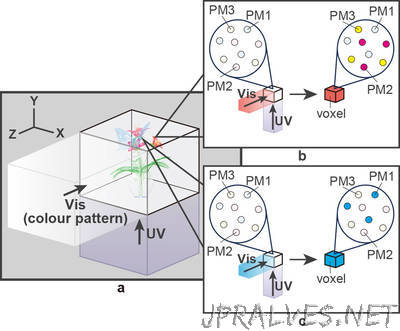
“In volumetric displays, 3D images are rendered directly onto a physical volumetric space.1–3 These images can then be viewed by observers without the need for any additional devices. The application space for displays such as these includes 3D visualization for medical applications, human-computer interactions, architectural design, entertainment, and advertising. Indeed, some applications based on unique 3D volumetric-display architectures have already been proposed. Controlling volume elements (voxels) that are arranged in a 3D layout in the same manner by which pixels are controlled in conventional 2D displays presents a challenge, however. For example, the use of LEDs as voxels6 necessitates the presence of electrical wiring, which deteriorates the spatial resolution and induces occlusion in the displayed images. There exist a number of approaches to developing optically controlled volumetric displays that are capable of rendering 3D images without the need for wiring.7–12 Most of these approaches involve focusing a high-power laser beam at an arbitrary point in the volume, thereby inducing visible physical phenomena (e.g., plasma emission or photoluminescence) to produce numerous areas of light that together form a 3D image. In such approaches, three primary-color fluorescent materials (i.e., red, green, and blue) are placed at different positions relative to one another to achieve a full-color image. As such, these display devices require complicated structures (e.g., a stack of multiple thin layers).”
